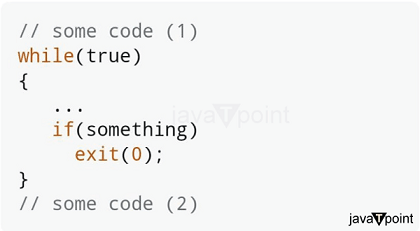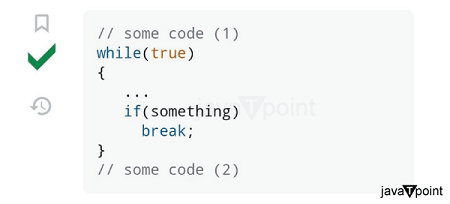Difference between exit() and break in C/C++IntroductionThe C and C++ programming languages provide different structures to control the flow of program execution. The exit() and break are two different mechanisms with different purposes. The purpose of this discussion is to provide a comprehensive understanding of the differences between exit() and break, including their functions, use cases, and impact on program execution. Exit() Function:The exit() function is part of "cstdlib" in header C++ and "stdlib" in C. Its main purpose is to stop the execution of the entire program and return control to the operating system. The exit() function takes an integer argument that acts as an exit status. By convention, a return value of 0 indicates successful execution, while a non-zero value indicates an error or abnormal termination. 
Syntax:It has the following syntax: The most important feature:
Use cases:Use exit() when an unrecoverable error occurs, and the program must exit immediately. Typically used in scenarios where further execution is not possible or safe. Disadvantages:No cleanup: The exit() method does not allow regular cleanup operations, such as freeing resources or calling destructors. Block statement:A loop statement is a control statement used in loops (such as for, while, and do-while) and switch statements. Its main function is to change the control flow of these structures. When an interrupt occurs, it causes an immediate exit from the loop or switch, passing control to the next statement in the loop or switch. Break StatementA basic control flow statement in C and C++ that is used to prematurely end the execution of a loop or switch statement is the "break" statement. It gives programmers the ability to break the regular flow of control inside a switch block or loop depending on specific criteria. In both languages, the "break" statement is a fundamental building block that provides versatility as well as efficiency in controlling program flow. Uses of Break Satement:The "break" statement has two main uses in both C and C++: 1. Loop Breaking: The "break" statement in a loop (like "for", "while", or "do-while") enables the computer to end the loop instantly, skipping any further iterations. This characteristic is very helpful when a specific requirement is satisfied and more iterations are either unneeded or unwanted. 2. Statement of Switch: The "break" statement is used in a "switch" statement to end the processing of a certain "case" block. The "break" statement is usually used to exit the switch block and stop the execution of further "case" labels after a matching "case" label has been located and executed. This method makes sure that, depending on the outcome of the switch expression, only the relevant code block is executed. Syntax:It has the following syntax: 
Differences between exit() and break:
There are several differences between the exit() and break statement in C/C++. Some main differences between the exit() and break() statements are as follows: 1. Context of use:Exit(): It is primarily used to terminate the entire program, returning control to the operating system. break: It is used in loops and switch statements to change the control flow of these structures. 2. End of program:exit(): It causes the entire program to terminate immediately. break: It does not end the program; it only exits the circuit or switch where it is used. 3. Cleaning and exterminators:Exit(): It does not allow execution of cleanup code or object destructors. break: It allows you to perform loops or variable cleanup operations, including calling local variable destructors. 4. Area of influence:exit(): It has a global scope that terminates the program regardless of its current state. break: It has a local scope, affecting only the loop or switch in which it is used. 5. Conditional vs. Absolute:exit(): It terminates the program unconditionally. break: It is usually used conditionally based on conditions in certain loops or switch statements. Conclusion:In C and C++, both exit() and break are control flow mechanisms, each serving different purposes in program execution. The main difference lies in their scope, intended use cases, and their impact on program flow. The exit() function is found in the "cstdlib" (C) or "stdlib" (C++) library and is a global termination mechanism. Its main purpose is to immediately halt the entire program and its execution, which makes it particularly useful for handling critical errors or abnormal conditions when continuation becomes infeasible. When exit() is called, the program exits without executing any subsequent code, including cleanup routines or destructors. It also allows the program to pass a status code to the operating system to help identify the reason for the termination. On the other hand, the break statement is more of a local control flow tool, mainly associated with loop structures (such as for, while, or do-while) and switch statements. Its purpose is to prematurely exit the nearest closing loop or switch when a certain condition is met. Unlike exit(), break does not terminate the entire program; instead, it allows the program to continue the statement immediately after the loop or switch. It makes the break invaluable in situations where a special iteration or case in a loop or switch becomes unnecessary or unwanted. In practice, exit() is typically used in unrecoverable error scenarios to ensure quick and final program termination, while loops or switch statements use breaks to selectively interrupt their normal flow based on condition evaluations. The choice between them depends on the requirements of the program: exit () for global termination due to critical errors and break for more precise control of loop and switch execution. Understanding these differences allows programmers to use these constructs effectively, increasing the robustness and flexibility of their C and C++ programs.
Next TopicInteresting facts about C++
|
 For Videos Join Our Youtube Channel: Join Now
For Videos Join Our Youtube Channel: Join Now
Feedback
- Send your Feedback to [email protected]
Help Others, Please Share









